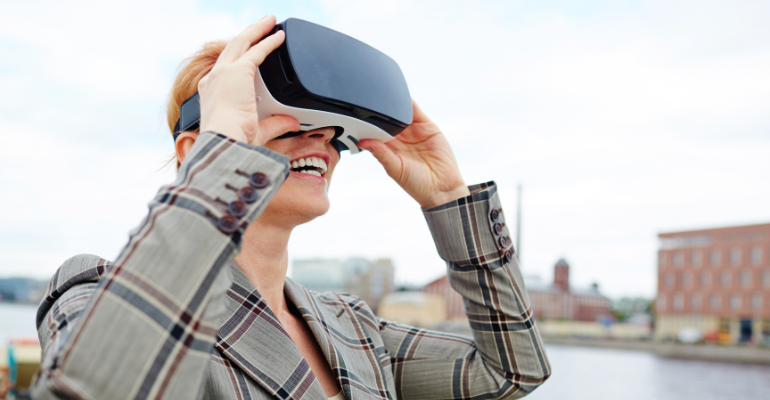Cruise Industry VR And AR Applications
The cruise industry has quickly embraced the potential of VR and AR to enhance the overall experience for passengers. One of the most exciting applications of these technologies is in virtual tours and immersive experiences. With VR, cruise passengers can step into a virtual world and explore destinations from the comfort of their ship. Imagine walking through the bustling streets of Rome, marvelling at the ancient architecture and feeling like you’re actually there. AR, on the other hand, can overlay digital information onto the real world. This allows passengers to learn about the history and significance of the places they’re visiting. This technology can transform a simple walk around a historic port into a fascinating educational experience.
The Benefits Of Using VR And AR In Cruise
These are numerous; firstly, these technologies can offer a level of immersion that is simply not possible with traditional methods. Instead of relying on brochures or photos, passengers can truly feel like they’re part of the destination they’re exploring. This can create a deeper connection and appreciation for the places they visit. Additionally, VR and AR can provide a more inclusive experience for passengers with mobility issues. They can explore areas virtually that may be otherwise difficult or impossible for them to access in person.
VR And AR Technologies For Cruise Passengers
Cruise lines are constantly investing in the latest VR and AR technologies. For example, some cruise ships now offer VR headsets in their onboard entertainment areas. These allow passengers to immerse themselves in virtual worlds and in games. Indeed, VR and AR can take entertainment and activities on a cruise ship to a whole new level. Imagine attending a live concert where the stage is transformed into an interactive virtual environment. You can dance alongside your favourite artists, explore fantastical landscapes and be a part of the show like never before. AR can also enhance traditional activities such as scavenger hunts or trivia games by adding a digital layer of interactivity. Passengers can use their smartphones or AR glasses to uncover hidden clues or participate in virtual challenges.
Cruise passengers can also now explore famous landmarks, historical sites and natural wonders without leaving the ship. With VR headsets, they can walk through the corridors of the Louvre or dive into the Great Barrier Reef. These virtual tours not only provide a unique and engaging experience but also allow passengers to preview destinations and plan their onshore activities more effectively.
AR-Based Navigation And Information Systems On Cruise Ships
Some ships now have AR-based navigation systems that can provide real-time information about the ship’s location, upcoming ports, and even nearby points of interest. Finding your way around a large cruise ship can sometimes be a daunting task, especially for first-time cruisers. This is another area where AR-based navigation and information systems can come in handy. By using AR glasses or smartphone apps, passengers can access real-time maps and directions to help them. These systems can also provide information about onboard facilities, dining options and entertainment schedules. By combining AR with GPS technology, cruise lines are able to offer a seamless and intuitive navigation experience for their passengers.
Personalised Customer Experiences
Personalisation is a key focus for many industries and cruise is no exception. VR and AR technologies offer unique opportunities for cruise lines to create personalised experiences for their passengers. For example, using facial recognition technology, VR headsets can customise virtual tours based on individual preferences. If you’re interested in history, the virtual tour might focus on the historical aspects of a destination. If you’re a nature lover, the tour might highlight the natural beauty and wildlife.
The Challenges And Limitations Of Using VR And AR In Cruise
VR and AR have the potential to enhance the cruise experience in countless ways. However, there are still some challenges and limitations to consider. Firstly, the cost of implementing and maintaining these technologies can be significant. Cruise lines need to invest in hardware, software and training to ensure a seamless experience for passengers. Additionally, there may be technical limitations. For example, the need for a stable internet connection or the availability of VR and AR content for specific destinations. Finally, some passengers may have motion sickness or discomfort when using VR headsets.
Future Trends And Advancements
As technology continues to evolve, so does the potential for VR and AR. Future trends include the development of more compact and lightweight VR headsets, improved motion tracking and enhanced visual quality. Additionally, advancements in AR technology may allow for more seamless integration with the real world, creating even more immersive experiences. As cruise lines continue to invest in these technologies, the possibilities for enhancing the cruise experience are limitless.
Conclusion
The cruise industry is embracing the power of VR and AR. From virtual tours and immersive experiences to personalised customer interactions, these technologies are transforming the way we cruise. By blending the digital world and the real one, VR and AR have the ability to transport us to new dimensions and create unforgettable memories. While there are still challenges and limitations to overcome, the future of VR and AR in the cruise industry looks bright. So, the next time you embark on a cruise, be prepared to be amazed by the immersive and captivating experiences that VR and AR can bring to your journey.

